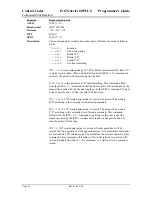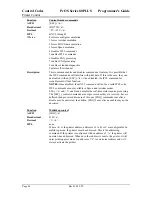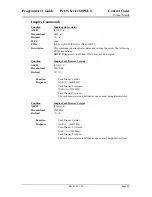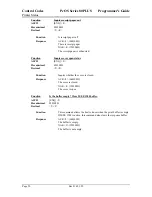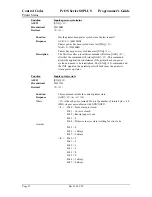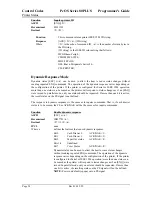
Programmer's Guide
PcOS Series 80PLUS
Control Codes
Bar Codes
Rev B 4/13/99
Page 43
printer will convert an ASCII ‘A’ (<65>) to a <33> internally which forces
Code 128C and the start codes off by 32.
UPC A
This is a fixed length, numeric, continuous code that employs four element
widths. The printer supports Universal Product Code Versions A, E, EAN-
8, and EAN-13. Version A encodes 11 digits. Typically, the UPC A format
starts with a number system digit, 5-digit manufacturer’s code, 5-digit
product code, and a check digit. The printer makes no assumptions about
any of the codes except the check digit. The printer will print a UPC bar
code with the 11 digits sent to it and generate the check digit. If fewer than
11 digits are sent, the remaining digits will be 0. The printer will print a
UPC that is about 130% the size of the UPC nominal standard. This
provides optimal readability.
UPC E
This is a zero suppression version of UPC. The printer requires that the
first digit be 0 for number system 0. If it is not zero, the bar code is not
printed. The printer does the compression based on the compression rules
for UPC E. The printer will print a UPC bar code based on the 11 digits
sent to it and generate the check digit. If fewer than 11 digits are sent, the
remaining digits will be 0. The printer will print a UPC that is about 130%
the size of the UPC nominal standard. This provides optimal readability.
EAN-13
This is a fixed length, numeric, continuous code that employs four element
widths. The printer supports EAN-13, a superset of UPC that encodes 12
digits. Typically, the format starts with a number set digit, which defines
how the next 6 digits are encoded. The next 5 digits have fixed encoding.
The last is a check digit. The printer will print an EAN-13 bar code with
the 12 digits sent to it and generate the check digit. If fewer than 12 digits
are sent, the remaining digits will be 0. The printer will print an EAN-13
bar code that is about 130% the size of the nominal standard. This provides
optimal readability.
EAN-8
This is a fixed length, numeric, continuous code that employs four element
widths. The printer supports EAN-8, a superset of UPC that encodes 7
digits. The printer will print an EAN-8 bar code with the 7 digits sent to it
and generate the check digit. If fewer than 7 digits are sent, the remaining
digits will be 0. The printer will print an EAN-8 bar code that is about
130% the size of the nominal standard. This provides optimal readability.
NOTES:
A [CR] may also be used in place of the [ETX] to end the bar
code data field.
Only information that is usable in a particular bar code will be printed.
Function
Bar code height
ASCII
[ESC] [EM] B <n>
Hexadecimal
1BH 19H 42H <n>
Decimal
<27><25><66><n>
IPCL
&%BH <m
1
> <m
2
>
Description
This command sets the bar code height and speed where <n> is the number
of print passes and <m> is the speed. Each pass is about 0.11 inch high. If
n = <0>, the printer returns to the default values of four passes for all
except UPC which is seven. Any value from 0 to 9 may be specified.






